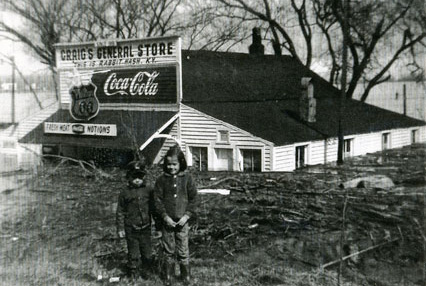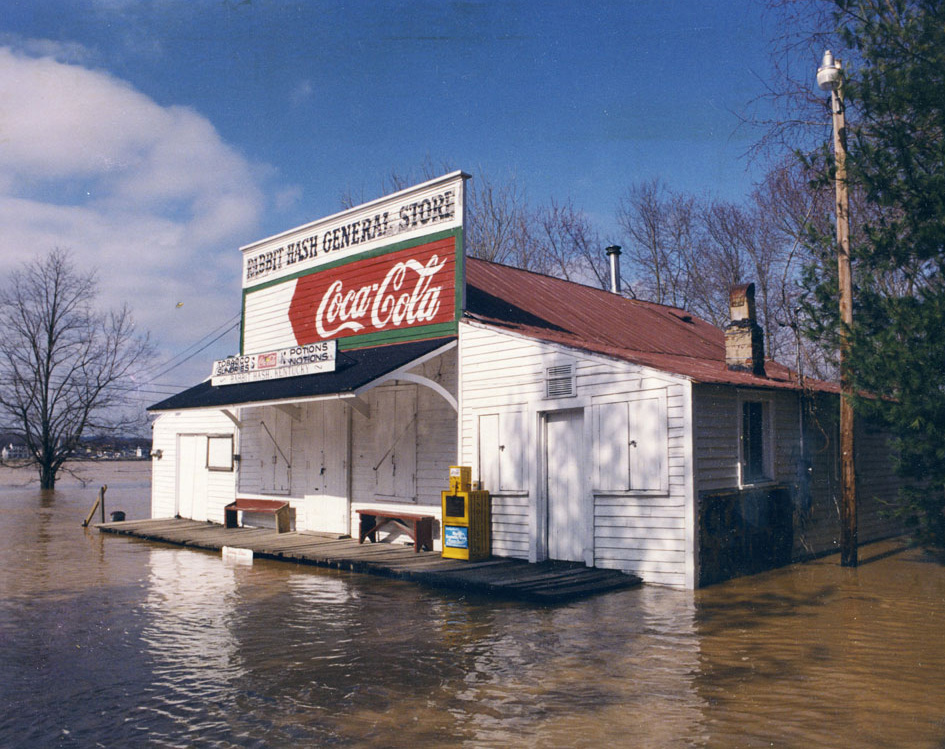
Rabbit Hash General Store, circa 2004. (Photo by Paul Tenkotte)
By Don Clare
Special to the NKyTribune
That old building had personality. It hugged you like a grandma would. It welcomed you like your favorite old hound. It was a part of your family. That old wood stove put out the kind of heat that penetrated into the very marrow of your bones and made you sleepy like the Tryptophan exuding from your mother’s Thanksgiving turkey meat. The place offered solace from your stress and worries; comfort from your pain and agony (both real and perceived); and friendship if you had no friends.
Here was a place where you could lie with confidence, because everyone already knew the truth but enjoyed a “good” lie. Stories shared, songs sung, poems recited, politics argued, and religion held in the highest regard but not immune to criticism. This is the Rabbit Hash General Store, the sounding board and great equalizer of a small, rural, agrarian community along one of this nation’s major and most beautiful inland waterways. River born, Kentucky bred.

The Flood of 1937 (Courtesy of the RHHS Collection at Boone County Public Library)
Some called the Rabbit Hash General Store “the pulse of the community” or the “clearinghouse” of the town. Rabbit Hash is more of a hamlet than it is a town. Just ask someone from Boone County where they live. Most people refer to it as simply “the store.” People know what you are describing and where.
When reduced to its most common denominator, Rabbit Hash, Kentucky is “just a state of mind.” There are bumper stickers around that will confirm this. The General Store is the entity that gives this abstract description some bulk, form and concreteness and palpability. Do you believe in “potions and notions”? One spring weekday, just take a drive down to Rabbit Hash and sit between the remains of the store and the river. There is a certain “something” that that Ohio River gives off that will lower your systolic and diastolic blood pressure by twenty points. And that same “something” will allow you to look at the remains and see the future store, not the carcass of the original one.
You have to go all the way back to 1831 to witness the birth of the Rabbit Hash General Store. Of course, it was not called that because there was no such place as Rabbit Hash. But there was the Carlton Magisterial District and this was where the farming community in the region lived and worked. There came a point in time that the local farmers realized that they needed a more organized way of shipping their produce up or down the river, other than standing on the riverbank and randomly flagging down the up-bound or down-bound steamboats that passed.

‘At the Stoveside,’ by renowned photographer Paul Briol. Courtesy of the RHHS Collection at the Boone County Public Library.
These farmers were members of a farming fraternal organization called The Grange (something that Thomas Jefferson himself came up with). And they got together and decided to construct a central, mutually shared structure to store their crops for the steamboat trade. But there was an expansive sandbar on this Kentucky side of the river, so they had to ferry their goods over to Rising Sun, Indiana, where the steamboats had plenty of water depth to land.
This original storage structure was actually constructed from a wooden river barge which was dismantled and re-used and re-adapted to make a timber-framed building. It consisted of four jointed plate logs, with an upright post attached to each corner, and crowned up top by four jointed plate logs. Wide, three-inch planks were then nailed to the front, back and sides with blacksmith hand-made iron spikes from the plate logs down to the sill logs, serving as the weight-bearing strength of the building This is called balloon framing. There is no stud wall framing at all. The fire has been kind enough to allow us to verify this mode and fashion of construction.
Eventually, the building came under the management and ownership of James Alexander Wilson, just seventeen years old at the time. He was also the owner and proprietor of the Rising Sun Ferry, as it was called at that time. The store remained in the Wilson family until it was sold to the Charles Craig family in 1931. Lowell Lee Scott purchased it in 1979 from Lib and Cliff Stephens (Lib was one of Charlie Craig’s daughters).
Louie Scott then proceeded to purchase every other parcel of land and building in what is now Rabbit Hash, Kentucky. He sold the town in its entirety to the Rabbit Hash Historical Society on December 13th, 2002. Since that time, the Rabbit Hash Historical Society has been preserving and maintaining the historic Boone County icon by employing as many of the tools in the preservation tool box as possible, most notably, adaptive re-use. Every building in this now National Register District has been kept alive and breathing by continual occupation and use, thus preventing stagnation and decay.

Gary M. White, proprietor of the Rabbit Hash General Store, circa late 1980s. Courtesy of the RHHS Collection at the Boone County Public Library.
The fire which destroyed the Rabbit Hash General Store on the frigid night of February 13, 2016 was ruled accidental by the fire commander who directed and managed the firefighting strategy of the five different local Boone County Fire Departments who responded. Through their concerted efforts, we were left with a stable foundation, floor, and three standing walls. A total loss? Perhaps to the casual looker visiting the tragic scene. But not to the Rabbit Hash Historical Society. There is still enough original fabric and integrity in the ruins to allow a complete restoration of the ancient, iconic gem of a structure, and that is exactly what this community has determined to do. We will restore the old gal and following the stringent guidelines of the Department of Interior’s Guidelines For Historic Preservation, she will be allowed to remain a National Register structure.
The surrounding community was especially relieved to learn from the work of a professional fire inspector that the cause of this horrendous conflagration was not the Rabbit Hash Iron Works’ wood stove that heated the building and its visitors for the past 35 years, but a faulty cooler in a back room. A community came together in 1831 to build this building, and a community is coming together in 2016 to rebuild this same building.
The Rabbit Hash Historical Society carried the maximum fire insurance allowed by the insurance company on the store and on its contents. But that alone will not cover the expense of complete and total restoration. That is why people from around the entire nation are rallying with individual and corporate donations to the restoration project. All work has to be approved and signed off by the State Historic Preservation Officer for Kentucky, representing the national entities of the National Park Service and the Department of the Interior, via the County Preservation Officer and the County Judge Executive and his county regulatory departments. After all this, then we can begin the actual work of restoration.
A highly acclaimed regional historic architectural firm has donated its expertise to prepare the necessary drawings for the project, and an equally acclaimed regional Cultural Resource Management and Historic Preservation Consulting Firm has donated its services as the project manager for the restoration. Many other in-kind services and material have also been pledged at no cost, including several historic houses and barns from which to obtain the necessary “like” building materials.

Flood of 1997. Courtesy of the RHHS Collection at the Boone County Public Library.
Please keep track of the numerous musical and riding benefits that are planned over the spring and summer, and support them as you can. They will be listed in many venues, including on the “Northern Kentucky History” Facebook page.
We are not at all close enough to the financial needs that are going to mount up. We desperately need your help and donations to succeed in this venture. A special fund at Forcht Bank on Route 18 in Burlington has been set up just for those of you who wish to donate directly to an account in a local bank, as opposed to an internet site. Simply mail your check to Forcht Bank, 6100 First Financial Drive, Burlington, Kentucky, 41005.
Over the past 185 years, the Rabbit Hash General Store has touched a plethora of hearts and souls in this county, this Commonwealth, and this nation, as well as in many international locations. It will be the generosity and fortitude of these hearts and souls that will once again re-establish the Rabbit Hash General Store.
Don Clare is a retired registered nurse. He loves history, Rabbit Hash, and the Ohio River, and has written for both The Encyclopedia of Northern Kentucky and Gateway City: Covington, Kentucky, 1815-2015.
























